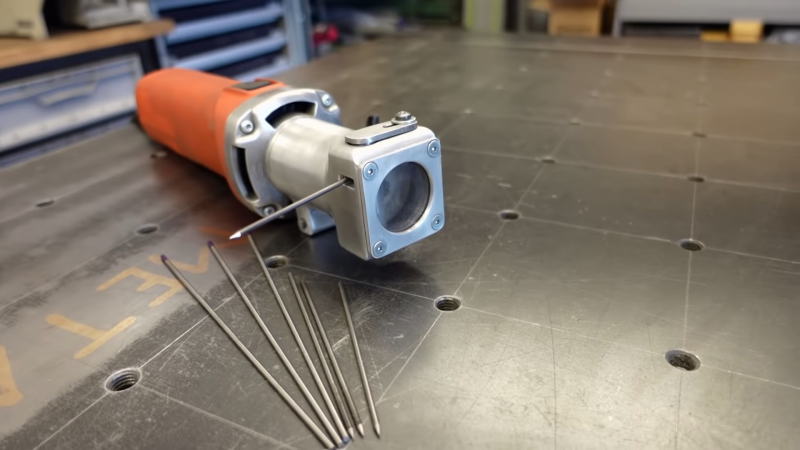Aspiring TIG welders very quickly learn the importance of good tungsten electrode grinding skills. All it takes is a moment’s distraction or a tiny tremor in the torch hand to plunge the electrode into the weld pool, causing it to ball up and stop performing its vital function. Add to that the fussy nature of the job — tungstens must only be ground parallel to the long axis, never perpendicular, and at a consistent angle — and electrode maintenance can become a significant barrier to the TIG beginner.
A custom tungsten grinder like this one might be just the thing to flatten that learning curve. It comes to us by way of [The Metalist], who turned an electric die grinder into a pencil sharpener for tungsten electrodes. What we find fascinating about this build is the fabrication methods used, as well as the simplicity of the toolkit needed to accomplish it. The housing of the attachment is built up from scraps of aluminum tubing and sheet stock, welded together and then shaped into a smooth, unibody form that almost looks like a casting. Highlights include the mechanism for adjusting the angle of the grind as well as the clever way to slit the body of the attachment so it can be clamped to the nosepiece of the die grinder. We also thought the inclusion of a filter to capture tungsten dust was a nice touch; most TIG electrodes contain a small amount of lanthanum or thorium, so their slight radioactivity is probably best not inhaled.
We love builds like this that make a tedious but necessary job a little quicker and easier to bear, and anything that stands to make us a better welder — from simple purpose-built fixtures to large-scale rotary tables — is OK in our book.
















Nice. Being HAD I am stuck with the concept of an automatic cut-off rechargeable keychain “pencil sharpener.” Maybe LEDs bright enough to use mask-on, reservior might need to accept hot-stick.
It’s a great design, portable, compact, safety built-in and indeed as Dan noted, the high finish on the piece reflects the enthusiasm put into making it.
Tools that come about to fill a need, like this one, really highlight the form-follows-function aspect – it does exactly what the builder intended it to do, and obviously will become a well-used piece of shop equipment. Well done.
NIT: “most TIG electrodes contain a small amount of lanthanum or thorium so their[sic] slight radioactivity”
This is a little bit of a misrepresentation of radioactive part of TIG welding. There are many more Tungsten electrodes that the Lanthanum or Thorium electrodes. You buy the welding electrodes you need, if you need Thoriated electrodes, you buy Thoriated electrodes, if you need Lanthanated electrodes you buy Lanthanated electrodes, if you don’t need those things you can buy electrodes that don’t contain Thorium or Lanthanum. Personally I buy electrodes that don’t contain Thorium or Lanthanum because I weld in a residential area.
I’m already fighting other TIG welding disinformation from other sources (that also generalized that all/most TIG welding is radioactive), please try to avoid contributing more FUD.
Otherwise, great tool, I’ve been grinding mine with a 3D printed jig on the end of a dremel-type-thing, but it ends up melting. I’ve just gotten a metal jig, but haven’t yet sharpened anything with it yet. Would be great to have enclosed grinder.
Try chemical sharpening and see how you like it.
I didn’t think lanthanated tungsten was appreciably radioactive. It’s 1% lanthanum, and lanthanum is 99.9% the non-radioactive isotope.
I’ve so much thoriated tungsten from years of welding, but have moved entirely to ceriated or lanthanated coz of discomfort with the thoriated (which is several times background radiation when I get it near my geiger counter.)
half life of 138 La is 102 billions years…
The half life of 180 W (Tungsten) is 1.8 quintillion years.
Impressive bit of work. A bit more complicated than I think it needs to be. Just my thought.
An attachment like this is around $20 where I am. Like many things on HA it’s about the process and the challenge, not cost or necessity. In that case why not make it as complicated as you like?
Edit “$120”
It’s interesting to compare the approaches. A machinist would make the end piece out of square stock and attach the tube, while the welder adds metal to the end of the tube to build it up.
It’s a nice build. It’s not the best way to grind a TIG electrode though. I have only used this approach, with an angle grinder, when a bench grinder was unavailable. Grinding vertically on the edge of the grinder produces straight lines on the electrode tip, and therefore a smoother path for the electrons to flow. This is how we were taught at Lincoln Electric. Obviously you can still weld with this method of grinding, even with a roughed up lazy ass grind, but it won’t be as enjoyable.
If you care about such details. I do.
A very well though-out though it does end up grinding the tungsten perpendicular to the electrode which I find makes a difference even on the crude tig work I do. I find putting the electrode in a drill chuck and grinding it along a belt sander works just peachy – I just make sure to swap a belt that isn’t full of other junk already.
This guy is extremely talented, but he really would benefit from a lathe.